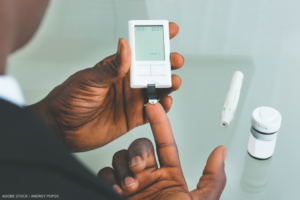‘We don’t often think about diabetes as a rheumatic disease,” says Dr. Bharat Kumar, “but it has a lot of musculoskeletal and immunologic manifestations. Recognizing these manifestations can help rheumatologists better manage their patients and direct therapy.’
Diabetes mellitus is an increasingly prevalent disorder, affecting nearly 12% of the U.S. population, with an additional 38% of the population having prediabetes. Thus, diabetes is a common comorbidity among patients with rheumatic disease.1
As rheumatologists, we often reckon with diabetes when reaching for corticosteroids to stamp out active inflammation, given that steroids can worsen insulin resistance and cause hyperglycemia. Brittle and difficult-to-control diabetes may entirely preclude the use of corticosteroid therapy.
 Diabetes itself can present with an array of non-inflammatory rheumatic manifestations that may mimic inflammatory diseases, such as rheumatoid arthritis, scleroderma and myositis. Rheumatic manifestations of diabetes can lead to functional limitations that impede exercise and further compromise glycemic control, although they are often overshadowed by the more familiar complications of microvascular disease, such as neuropathy, retinopathy and nephropathy.2 Indeed, the musculoskeletal manifestations of diabetes are not mentioned in the practice guidelines from the American Diabetes Association.3,4
Diabetes itself can present with an array of non-inflammatory rheumatic manifestations that may mimic inflammatory diseases, such as rheumatoid arthritis, scleroderma and myositis. Rheumatic manifestations of diabetes can lead to functional limitations that impede exercise and further compromise glycemic control, although they are often overshadowed by the more familiar complications of microvascular disease, such as neuropathy, retinopathy and nephropathy.2 Indeed, the musculoskeletal manifestations of diabetes are not mentioned in the practice guidelines from the American Diabetes Association.3,4
In this review, we explore the lesser known rheumatic entities of diabetes, such as diabetic cheiroarthropathy, scleredema and diabetic myonecrosis, with clinical pearls and insights provided by experts in the field. We also highlight the common musculoskeletal diseases with increased incidence in patients with diabetes, such as carpal tunnel syndrome, Dupuytren’s contracture and stenosing tenosynovitis. For each entity, we discuss the presenting signs and symptoms, diagnosis and management.
Diabetic Cheiroarthropathy
Diabetic cheiroarthropathy has many different illustrative names, including the syndrome of limited joint mobility, diabetic contractures, stiff hand syndrome and diabetic stiff hand. It is characterized by a progressive resistance to passive and active range of motion, often beginning in the hands, and seen in patients with diabetes.
Nilanjana Bose, MD, a rheumatologist in private practice at Lonestar Rheumatology, Houston, and an adjunct professor with the University of Texas Medical Branch at Galveston, notes, “Although [diabetic cheiroarthropathy] isn’t seen routinely, it is a diagnosis that you have to keep in your differential for joint stiffness.”
Importantly, it is a painless entity, and patients will present with “contractures and fibrosis with waxy skin on the hands. Distinguishing it from rheumatoid arthritis should be fairly straight forward for the rheumatologist,” says Dr. Bose. It can also be distinguished from Dupuytren’s contracture given the absence of thickening or nodularity of the palmar fascia.5




